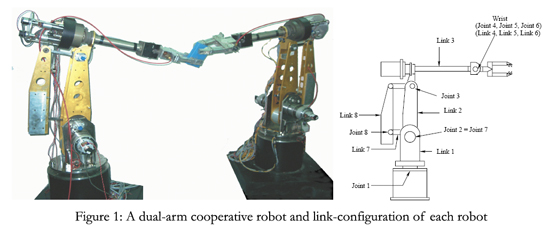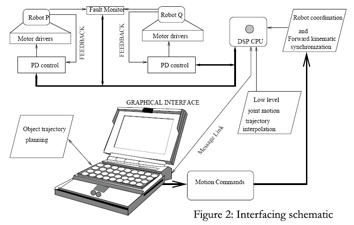Introduction
Industrial units that handle hazardous items often feel the
need for robotic devices to minimize risk to their employees.
Chemical units, bio-waste disposal agencies and nuclear
power plants are a few such entities where robotic arms help
reduce the risk of injury and infection to humans. An effort
in
this direction was made by the development of a dual-arm
robotic system as a collaborative project between Bhabha
Atomic Research Centre (BARC) and IIT Bombay.
In contrast to automation systems, where
the task and
the product is well defined and routine, a dual-arm robotic
system
must have reasonable flexibility in the task definition.
The
ideal system should have the dexterity of a pair of human
hands and the intelligence to judge the easiest way to finish
a
task. A single robotic arm may perform well on routine pickplace
jobs but may not be competent to handle complex
manipulation like transferring a liquid from one container
to
another or handling a flexible sheet.
Arm Configuration, Electronics and Interfacing
Each of the pair of robotic arms, (Figure 1) has an anthropomorphic
(human type) elbow configurations with six joints.
There are three joints at the wrist that support the gripper
(the
end-effector) and the arm itself has three more joints
to position
the wrist at the desired location. A parallelogram mechanism
is added to the links to provide dynamic balancing and
decoupling of the link Coriolis forces. The arms are capable
of
handling upto 15 Kg weight. The link lengths are 425 mm
and
400 mm respectively, giving a wrist reachable distance
of
approximately 800 mm. The end-effector is presently a forktype
pneumatically actuated gripper. This can be replaced by
an instrumented gripper, having a force-torque embedded
sensor
and controlled gripping movement to handle delicate
objects. The end-effector can also be a tool or a sensor
to cut
and inspect the object, if required. The weight of each
robot is
about 50 Kg. The complete system with its control hardware
requires about 3 meters × 3 meters space.
 The control system (Figure 2) is designed
so as to facilitate
continuous upgradation and experiments in the hardware.
The robots are powered by DC servomotors. The motor
control is achieved by a feedback control system based
on a
PC. These motors are coupled to encoders to generate
feedback
information. There are limit switches at the joint ends
to
trip the power supply in the event of malfunctioning.
The
motors are connected to their respective amplifiers which
use
Pulse Width Modulated (PWM) signals generated using the
output from the PC Interface Card. Feedback from the
sensors
and limit switches are connected to a PC Interface Card.
This
card is also like an independent computer. It has one
DSP
processor with memory modules, D/A converter and EPROM
to store data and code. It can communicate with the host
computer
using an ISA bus. The card has its own program structure
that can be used to
process encoder data and
set different parameters
to establish a closed loop
control. For simple applications
this card has sufficient
memory and programming
capabilities to
be used without any
interfacing with a PC.
The control system (Figure 2) is designed
so as to facilitate
continuous upgradation and experiments in the hardware.
The robots are powered by DC servomotors. The motor
control is achieved by a feedback control system based
on a
PC. These motors are coupled to encoders to generate
feedback
information. There are limit switches at the joint ends
to
trip the power supply in the event of malfunctioning.
The
motors are connected to their respective amplifiers which
use
Pulse Width Modulated (PWM) signals generated using the
output from the PC Interface Card. Feedback from the
sensors
and limit switches are connected to a PC Interface Card.
This
card is also like an independent computer. It has one
DSP
processor with memory modules, D/A converter and EPROM
to store data and code. It can communicate with the host
computer
using an ISA bus. The card has its own program structure
that can be used to
process encoder data and
set different parameters
to establish a closed loop
control. For simple applications
this card has sufficient
memory and programming
capabilities to
be used without any
interfacing with a PC.
The PC is used to compute
the set points or the
desired trajectories of
the robots. It is also used
to program the interface
card’s internal code
module and set its
parameters. The software
is developed inhouse
and the source
code therefore, is readily
available for improvement
and analysis. The pair of robots is easy to operate.
A graphical
user interface is available to command the robots using
the mouse. Alternatively, a pre-planned trajectory can
be fed
in the form of a data file using the facility in the
software.
Research Implications
Tasks such as pouring a liquid from one container to
another,
pushing a piston into a cylinder or turning the tap
of a valve,
are few such examples that need two arms to work in
cooperation
and in synchronism. These tasks, though appear ordinary,
call for extraordinary dexterity properties in the
robots’ workspace. In the
case of single arm robots, to avoid the dexterity
constraints, the workspace is pre-planned and structured,
with pick-up points and placement point positioned
according to the task’s requirement of desired orientations.
However, in the case of dual-arm manipulators, the
robotic
arms need to maintain the orientation of their end-effectors
with reference to each other, either constant or at
some desired
magnitude throughout their trajectories spanning a
large area
of their workspace. An example can be given as pushing
a piston
into a cylinder. In this task the two end-effectors
must maintain
the same orientation while moving towards each other
in
order to push the piston. The successful execution
of this apparently
simple task is surprisingly dependent on many factors
such as the length of the travel, the distance between
the two
robots, initial orientation of the cylinder and joint
limits. It is,
therefore, essential that the task is carefully planned
in the section
of the workspace where task specific orientation and
location
demands are satisfied. The studies on this aspects
have
resulted in the development of algorithms that makes
the planning
of the tasks more systematic.
The dual-arm system, developed
from scratch, also gives an opportunity to students of various
disciplines
such as
Electrical, Electronics, Mechanical, Computer Science
and
Industrial Design, to modify, improve, experiment
and prove
their skills on a working system.
Contact: banavar@iitb.ac.in.